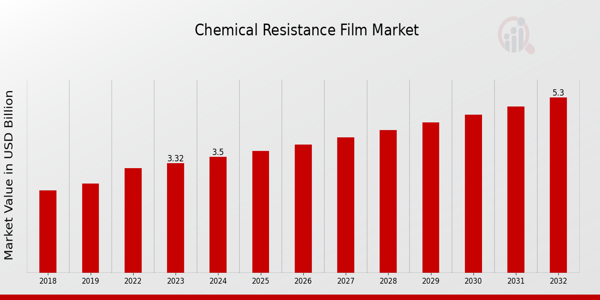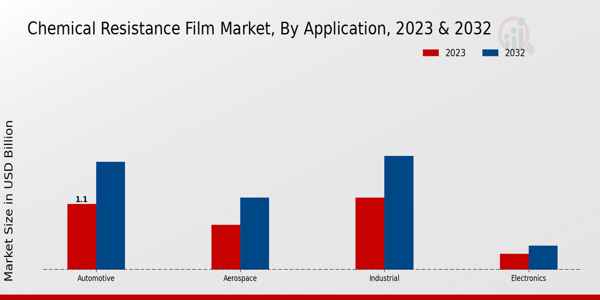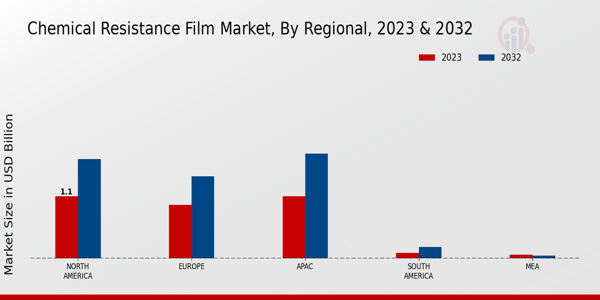Global Chemical Resistance Film Market Overview
The Chemical Resistance Film Market Size was estimated at 3.69 (USD Billion) in 2024. The Chemical Resistance Film Industry is expected to grow from 3.89 (USD Billion) in 2025 to 6.21 (USD Billion) by 2034. The Chemical Resistance Film Market CAGR (growth rate) is expected to be around 5.3% during the forecast period (2025 - 2034).
Key Chemical Resistance Film Market Trends Highlighted
The Chemical Resistance Film Market is experiencing significant growth driven by increased demand across various industries such as automotive, packaging, and healthcare. The rising need for durable and high-performance materials that can withstand harsh chemicals is propelling manufacturers to innovate and develop advanced film products. Additionally, stricter regulations on materials used in several applications are leading companies to seek out chemical-resistant solutions. Technological advancements in film processing and material science play a crucial role in enhancing product performance and expanding applications, thereby contributing to market growth.There are notable opportunities to be explored in the realm of eco-friendly and biodegradable chemical resistance films. As consumers and industries alike become more environmentally conscious, the demand for sustainable packaging solutions presents a favorable opportunity for manufacturers to introduce innovative products that meet these criteria. Moreover, the growing emphasis on safety and regulatory compliance in various sectors is driving the need for robust materials that ensure protection against chemical exposure. Companies that invest in research and development to create sustainable chemical-resistant films are likely to capture a significant share of the market.Recent trends in the market include a shift towards the development of multi-functional films that not only provide chemical resistance but also offer other features such as UV protection, tear resistance, and barrier properties. This trend is driven by the need for versatile materials that can cater to multiple requirements simultaneously. Furthermore, the rise of e-commerce and the expanding logistics sector are prompting an increase in demand for chemical-resistant packaging solutions, which offer enhanced protection for goods during transportation. Overall, the landscape of the Chemical Resistance Film Market is evolving rapidly, with various trends and opportunities shaping its future trajectory.

Source: Primary Research, Secondary Research, MRFR Database and Analyst Review
Chemical Resistance Film Market Drivers
Increasing Demand for Protective Solutions
The Chemical Resistance Film Market Industry is witnessing a significant boost in demand for protective solutions across various sectors. Industries such as automotive, electronics, and pharmaceuticals are increasingly adopting chemical resistance films due to their ability to provide a barrier against harsh chemicals and environmental factors. This trend is largely driven by the rise in safety regulations and standards, which necessitate the use of materials that offer superior protection for both personnel and equipment.As companies prioritize the safety of their operations and aim for sustainable practices, the adoption of chemical resistance films becomes essential. Furthermore, the growing awareness regarding occupational hazards and the need for compliance with environmental laws are propelling organizations to invest in advanced protective films. Consequently, this demand is expected to escalate, fueling growth in the Chemical Resistance Film Market Industry.With emerging markets in developing regions also contributing to this trend, the necessity for reliable and durable films suitable for a range of applications continues to drive up production and innovations in the industry.
Technological Advancements in Film Production
Innovations in technology are transforming the Chemical Resistance Film Market Industry by enhancing the quality and efficiency of film production. Advances in manufacturing processes, such as improved polymer chemistry and coating techniques, are enabling the production of films that are not only more resistant to various chemicals but also more versatile in their applications. As manufacturers embrace cutting-edge technologies, the functional properties of these films are being enhanced, promoting wider usage in critical industries.This technological progression ensures that products remain competitive, contributing positively to market growth.
Rising Investments in Research and Development
The Chemical Resistance Film Market Industry is experiencing a surge in investments aimed at research and development activities. Companies are increasingly allocating resources to innovate and develop high-performance films that cater to specific industrial needs. This focus on R is essential for launching novel products with improved chemical resistance and adaptability, thereby meeting the evolving demands of the market. Such investments not only promote growth but also position manufacturers to leverage emerging opportunities in various applications.
Chemical Resistance Film Market Segment Insights
Chemical Resistance Film Market Application Insights
The Chemical Resistance Film Market is positioned for notable expansion, with a market value of 3.32 USD Billion in 2023 and projected to rise to 5.3 USD Billion by 2032. The Application segment is pivotal in driving revenue, with distinct importance across various industries such as Automotive, Aerospace, Industrial, and Electronics. The Automotive segment is substantial, valued at 1.1 USD Billion in 2023, and expected to grow to 1.8 USD Billion by 2032, reflecting the increasing demand for durability and protection in automotive components against harsh chemicals and environmental factors, contributing significantly to the majority holding in the market.The Industrial sector holds a robust second position, with a valuation of 1.2 USD Billion in 2023 and reaching 1.9 USD Billion by 2032, showcasing the essential role chemical resistance films play in manufacturing processes and equipment protection, thus highlighting its significance in ensuring efficiency and longevity in operations. In the Aerospace application, the sector is valued at 0.75 USD Billion in 2023 and projected at 1.2 USD Billion by 2032, underlining the critical requirement for lightweight and durable materials to withstand challenging conditions, thus emphasizing its significance within the industry.Meanwhile, the Electronics segment is comparatively smaller, at 0.27 USD Billion in 2023, ascending to 0.4 USD Billion by 2032, reflecting the specialized applications of chemical resistance films in protecting sensitive electronic components against chemical exposure, though it lags behind in overall market contribution. The growth trajectory of the Chemical Resistance Film Market is propelled by factors such as increasing industrial applications, technological advancements, and a heightened focus on product quality and longevity across these diverse segments.However, challenges such as fluctuating raw material prices and stringent regulatory standards must be navigated to leverage the opportunities presented in expanding applications of chemical resistant solutions. Overall, the market displays varied dynamics, with each application offering unique strengths and growth potential as illustrated by the provided market data.

Source: Primary Research, Secondary Research, MRFR Database and Analyst Review
Chemical Resistance Film Market Material Type Insights
The Chemical Resistance Film Market, valued at 3.32 (USD Billion) in 2023, is poised for significant growth as it caters to diverse industries requiring materials that can withstand harsh chemicals. In the realm of Material Type, options such as Fluoropolymer, Polyurethane, Polyethylene, and Polyvinyl Chloride play pivotal roles. Fluoropolymers dominate due to their exceptional chemical resistance and thermal stability, making them essential in specialized applications. Polyurethane films have gained traction because of their flexibility and durability, which makes them popular in various industries.Meanwhile, Polyethylene is recognized for its cost-effectiveness and versatility, catering to a wide range of applications. Polyvinyl Chloride also holds a substantial share due to its resistance to abrasions and corrosion. The increasing demand across sectors like automotive, electronics, and healthcare drives the growth of these materials, contributing to the overall market dynamics reflected in the Chemical Resistance Film Market statistics. As industries evolve, these material types are expected to adapt, presenting opportunities for innovation and expansion within the market, thus enabling sustained market growth.
Chemical Resistance Film Market End-Use Industry Insights
The Chemical Resistance Film Market, anticipated to be valued at 3.32 USD Billion in 2023, exhibits a diverse landscape across various segments, particularly focusing on the End-Use Industry. Within this context, key areas such as Chemical Processing, Healthcare, Food and Beverage, and Marine play pivotal roles in shaping the market dynamics. The Chemical Processing sector relies heavily on these films to withstand harsh chemicals and extreme environments, ensuring safety and durability. Similarly, the Healthcare industry demands high-performance films for applications that protect equipment and maintain hygiene standards.The Food and Beverage sector benefits from these films due to their ability to maintain product integrity and protect against contamination. Meanwhile, the Marine sector utilizes chemical resistance films to safeguard vessels from corrosive environments, demonstrating the versatility and essential nature of these solutions. Collectively, these applications significantly contribute to the Chemical Resistance Film Market revenue, highlighting the importance of these sectors in driving demand and innovation. Market trends suggest an increasing focus on sustainability and advanced material development, which continues to enhance the growth potential across these industries.
Chemical Resistance Film Market Thickness Insights
The Chemical Resistance Film Market is forecast to be valued at 3.32 USD Billion in 2023, with the thickness segment playing a crucial role in shaping market dynamics. This market segmentation encompasses various categories, including films less than 50 microns, those between 50-100 microns, 100-150 microns, and those exceeding 150 microns. Films in one of the lower thickness categories, specifically under 50 microns, are widely utilized in applications requiring flexibility and lightweight properties, fulfilling the needs of numerous industries.Meanwhile, the 50-100 microns range holds a significant position due to its balance between durability and flexibility, catering to sectors like automotive and electronics. The 100-150 microns segment offers enhanced chemical resistance, making it particularly beneficial in industrial applications. Lastly, films thicker than 150 microns dominate applications that necessitate higher protection levels, such as in construction and heavy-duty packaging. The overall market trends indicate substantial growth driven by increasing demand across varied industries, although challenges in sourcing raw materials and fluctuating prices persist.Despite these challenges, opportunities abound as technological advancements enhance film performance, positioning the Chemical Resistance Film Market for sustained growth.
Chemical Resistance Film Market Regional Insights
The Chemical Resistance Film Market, valued at 3.32 USD Billion in 2023, is exhibiting significant growth across various regions, suggesting an upward trend in demand for chemical resistance solutions. North America holds a major share, valued at 1.1 USD Billion in 2023, and is expected to reach 1.75 USD Billion by 2032, driven by advanced industrial sectors and strict regulatory frameworks. Europe follows closely, valued at 0.95 USD Billion in 2023 and projected to grow to 1.45 USD Billion by 2032, reflecting strong consumer safety standards.APAC also plays a vital role, showcasing growth from 1.1 USD Billion in 2023 to 1.85 USD Billion in 2032 due to rapid industrialization and increased investment in manufacturing. In contrast, South America, with a valuation of 0.1 USD Billion in 2023, is on the rise but remains the least dominant due to lower industrial output. Similarly, the MEA region accounts for 0.07 USD Billion in 2023, indicating emerging opportunities despite being comparatively smaller. The diverse growth across these regions highlights key market dynamics and influences shaping the industry.

Source: Primary Research, Secondary Research, MRFR Database and Analyst Review
Chemical Resistance Film Market Key Players and Competitive Insights
The Chemical Resistance Film Market has witnessed significant growth in recent years, driven by a rise in industrial applications across various sectors such as automotive, electronics, medical, and packaging. The demand for high-performance films that can withstand exposure to harsh chemicals has spurred innovation and competition within the market. Companies are increasingly focusing on product development to create films that offer superior mechanical properties, durability, and chemical resistance. This competitive landscape is characterized by a mix of established players and emerging firms striving to differentiate themselves through technology advancements, sustainable practices, and customer-centric solutions. As awareness surrounding the importance of chemical resistance in films continues to grow, key market players are investing in research and development initiatives to enhance their product offerings and capture a larger share of this burgeoning market.Covestro has established a strong presence in the Chemical Resistance Film Market through its commitment to innovation and high-quality products. The company is renowned for its advanced polymer materials that are engineered to provide exceptional resistance to various chemicals and environmental stressors. Covestro's strengths lie in its extensive research capabilities and technological expertise, allowing it to develop specialized films that meet the diverse requirements of industries. The company's focus on sustainability and customer collaboration has further solidified its position as a leading player in the market. By proactively addressing market needs and trends, Covestro not only enhances its product portfolio but also ensures its growth and competitiveness in the ever-evolving chemical resistance film segment.RTP Company stands out in the Chemical Resistance Film Market by offering a wide range of custom-engineered thermoplastic elastomers and specialty compounds that cater to specific industry requirements. The company’s extensive experience in materials science and processing provides it with a competitive edge in developing films that exhibit remarkable chemical resistance while maintaining versatility in application. RTP Company's strengths lie in its ability to tailor solutions for diverse customer needs and its commitment to high performance and quality in product delivery. Its strategic emphasis on collaboration with clients and end-users fosters the development of innovative film solutions that address unique challenges across various sectors. With a focus on technological advancement and customer satisfaction, RTP Company continues to enhance its market presence and strengthen its offerings in the chemical resistance film realm.
Key Companies in the Chemical Resistance Film Market Include
- Covestro
- RTP Company
- Wacker Chemie AG
- 3M
- SaintGobain
- Huntsman Corporation
- DuPont
- BASF
- Teijin Limited
- Mitsubishi Gas Chemical
- Eastman Chemical
- Sika AG
- Momentive Performance Materials
- SABIC
- AGC Inc
Chemical Resistance Film Market Industry Developments
The Chemical Resistance Film Market has seen significant activity, particularly with key players such as Covestro, RTP Company, and Wacker Chemie AG, enhancing their product lines to meet increasing demand across various industries, including automotive and construction. Recently, DuPont announced advancements in their chemical resistance film technology aimed at bolstering their market position. Additionally, 3M has focused on expanding its chemical-resistant coatings to cater to a growing customer base looking for durable and efficient solutions. In terms of mergers and acquisitions, significant movements include Huntsman Corporation's strategic acquisition of certain assets from Sabic, which has strengthened its portfolio in high-performance materials. Meanwhile, BASF has been engaged in collaborations focused on sustainability within the chemical-resistant film niche, aligning with trends toward eco-friendly products. The rising demand for chemical resistance films due to stringent regulations and heightened safety standards is pushing companies like Teijin Limited and Mitsubishi Gas Chemical to innovate and expand their operations. Overall, these developments indicate a robust and competitive landscape as companies adapt to market needs and explore growth opportunities through strategic partnerships and technological advancements.
Chemical Resistance Film Market Segmentation Insights
Chemical Resistance Film Market Application Outlook
- Automotive
- Aerospace
- Industrial
- Electronics
Chemical Resistance Film Market Material Type Outlook
- Fluoropolymer
- Polyurethane
- Polyethylene
- Polyvinyl Chloride
Chemical Resistance Film Market End Use Industry Outlook
- Chemical Processing
- Healthcare
- Food and Beverage
- Marine
Chemical Resistance Film Market Thickness Outlook
- Less than 50 microns
- 50-100 microns
- 100-150 microns
- More than 150 microns
Chemical Resistance Film Market Regional Outlook
- North America
- Europe
- South America
- Asia Pacific
- Middle East and Africa
| Report Attribute/Metric |
Details |
| Market Size 2024 |
3.69 (USD Billion) |
| Market Size 2025 |
3.89 (USD Billion) |
| Market Size 2034 |
6.21 (USD Billion) |
| Compound Annual Growth Rate (CAGR) |
5.3% (2025 - 2034) |
| Report Coverage |
Revenue Forecast, Competitive Landscape, Growth Factors, and Trends |
| Base Year |
2024 |
| Market Forecast Period |
2025 - 2034 |
| Historical Data |
2020 - 2024 |
| Market Forecast Units |
USD Billion |
| Key Companies Profiled |
Covestro, RTP Company, Wacker Chemie AG, 3M, SaintGobain, Huntsman Corporation, DuPont, BASF, Teijin Limited, Mitsubishi Gas Chemical, Eastman Chemical, Sika AG, Momentive Performance Materials, SABIC, AGC Inc |
| Segments Covered |
Application, Material Type, End Use Industry, Thickness, Regional |
| Key Market Opportunities |
Growing demand in pharmaceuticals, Expansion in automotive industries, Increased focus on sustainability, Advancements in polymer technology, Rising need for protective coatings |
| Key Market Dynamics |
growing industrial applications, increasing regulatory standards, advancements in material technology, rising demand for protective films, expanding end-user industries |
| Countries Covered |
North America, Europe, APAC, South America, MEA |
Frequently Asked Questions (FAQ) :
The Chemical Resistance Film Market is expected to be valued at 6.21 billion USD in 2034.
The Chemical Resistance Film Market is anticipated to grow at a CAGR of 5.3% from 2025 to 2034.
In 2034, North America is expected to have the highest market value at 1.75 billion USD.
The Automotive application segment is projected to be valued at 1.8 billion USD in 2034.
Some major players in the market include Covestro, 3M, DuPont, and BASF.
The Industrial application segment is expected to be valued at 1.9 billion USD in 2034.
The Aerospace application segment is valued at 0.75 billion USD in 2024.
The Electronics application segment is anticipated to reach a value of 0.4 billion USD in 2034.
South America is projected to grow from 0.1 billion USD to 0.2 billion USD in that period.
The Europe region is valued at 0.95 billion USD in 2024.

















